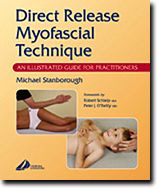|
|
Direct Release Myofascial Technique: An Illustrated Guide for Practitioners
Book Review
by
Jeffrey Kintish, DC
| Title: |
Direct Release Myofascial Technique: An Illustrated Guide for Practitioners |
| Author: |
Michael Stanborough
|
| Publisher: |
Churchill Livingstone
|
| Part #: |
T-270
|
 Michael Stanborough, a respected faculty member of the international Rolf Institute, has done well in presenting his deep-tissue methods in a short, deliberate text oriented toward the treatment of children and adults. Building on the work of Ida Rolf, Direct Release Myofascial Technique guides the practitioner toward the deeper levels of tissue, working with fascial planes and engaging the autonomic nervous system. This is by no means another passive approach to releasing stuck tissue; the patient is actively involved in freeing themselves. While the practitioner is moving toward deeper myofascial contacts, the patient creates a resistance by moving in opposing directions, actively. A release is experienced by both the practitioner and patient, which allows much deeper access to problem areas and varying states of relaxation.
Michael Stanborough, a respected faculty member of the international Rolf Institute, has done well in presenting his deep-tissue methods in a short, deliberate text oriented toward the treatment of children and adults. Building on the work of Ida Rolf, Direct Release Myofascial Technique guides the practitioner toward the deeper levels of tissue, working with fascial planes and engaging the autonomic nervous system. This is by no means another passive approach to releasing stuck tissue; the patient is actively involved in freeing themselves. While the practitioner is moving toward deeper myofascial contacts, the patient creates a resistance by moving in opposing directions, actively. A release is experienced by both the practitioner and patient, which allows much deeper access to problem areas and varying states of relaxation.
The manual therapist is encouraged to really feel the body and to nonverbally communicate with it. The effect expected is widespread and similar to the adjustment, e.g., stimulation of Golgi organs, decreased SNS activity, increased PNS, decreased muscle tone, breathing improvement, lymph flow improvement, better health, mental relaxation, and improved movement patterns, just to name a few.
During the first few chapters in section one, the author attempts to explain the mechanism behind this method and the theories that support it. As in most health care fields, including chiropractic, there is a lot we know and probably more we don't; this method is no different. One of my favorite chapters in this section is called "Tools of the Trade." I believe this might be the first time I have ever read about taking care of your hands. Here, you will learn how you should use your body properly while treating patients, and with any luck, avoid injuring yourself while helping others. Section two is called "Application of Techniques," and that's exactly what it covers - the treatment of myofascial release in the lower/upper extremities, pelvis, trunk, intraoral region, cervical region, head and face. Chapter 12 in this section becomes more specific, dedicated to the treatment of headaches.
Throughout this text are demonstrations in black-and-white photos of a patient and therapist in the proper setup positions. Each section of the body is represented and referenced, along with a brief explanation of contact, direction, technique, method, and comments regarding the area engaged. Although this book offers an excellent pictorial representation for this method, I believe this work would be delivered best in a DVD/VHS format. Learning myofascial methods by text leaves much to be desired and leaves the student missing the flow necessary for a complete understanding. That being said, overall I would consider this to be a good book on fundamentals, giving the reader a desire for more.
Dr.
Kintish's
Rating:
 9.5 out
of 10 9.5 out
of 10
|

|








